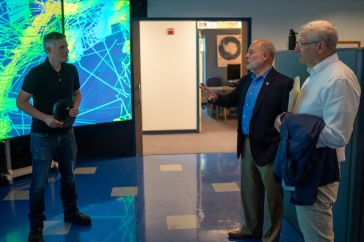
This image shows a future view of the world in equilibrium at 2,000 parts per million of atmospheric carbon dioxide (current level is 393 ppm). Sea level is higher by some 260 feet (80 meters) and vegetation is changed dramatically, with wide swaths of desert in North America. The image required several months of computing and Huber's collaboration with a National Geographic artist to create. Image courtesy of Matt Huber.
It wasn't until I listened to the first interview with Matt Huber I recorded for this story that it dawned on me: I knew this voice, knew its distinctive delivery, and it didn't belong to Huber. I was listening to Richard Dreyfuss as the marine biologist in the movie "Jaws."
Huber was an audio Dreyfuss doppelgänger with the same measured enunciation, throaty tone, and rising-falling inflection. There was even a hint of the actor's signature, congenial brashness and wry, ready sense of humor. A quick look at the film verified all this and, it turns out, the marine biologist's name is Matt Hooper.
After reviewing the story prior to publication, Huber told me that his uncle—writer, actor, and director Carl Gottlieb—co-wrote the screenplay for "Jaws" with author Peter Benchley, and is a longtime pal of Richard Dreyfuss.
Our scientist arrived early this semester at the Earth Systems Research Center and Department of Earth Sciences from Purdue University where he co-founded and served as director of the Purdue Climate Change Research Center. A paleoclimate modeler whose primary work is running vast general circulation model climate simulations aimed at understanding future climate, Huber still "plugs in" to the supercomputer at Purdue from his laptop—preferably, while sitting in a nearby café or coffee shop.
|
Matt Huber, photo by Anne Huber. |
If you come looking for Huber in his third-floor, Morse Hall office, more often than not you'll come away empty-handed.
"Says Huber, "Historically I've always worked in coffee shops because it helps keep you integrated into the stream of life, and that helps academics stay grounded, I think. It also makes me and my postdocs and students very accessible."
"And my students know that if we're going to work in the café they have to buy coffee or something every couple of hours to pay the rent. So if it's me, a postdoc, and three grad students, that means daily my group is throwing something like $50 into the local café's pocket," Huber says with a grin and Dreyfussesque laughter. "I know it sounds silly but I consider this sort of activity important, especially for an employee of the state. Engagement with society at all levels is vital. This can be done in many ways but I feel it is important to be connected with the local community and with students."
Huber's work probes the deep-time of Earth's climate history, which means it takes time; a typical model run churns away for one to three years before there's any output to analyze. In the interim, he and his team go through the data from the last years-long simulation, which generates a terabyte of data per day or roughly the equivalent of 1,000 copies of the Encyclopedia Britannica. That's a lot of data pored over, and a lot of coffee poured.
He was hired in part with funds from UNH's large National Science Foundation EPSCoR (Experimental Program to Stimulate Competitive Research) project that began two years ago and involves many EOS researchers and other scientists across campus and around the state. Among other things, the NH EPSCoR "Ecosystems and Society" project is aimed at better understanding complex interactions among climate, land use, ecosystem function, and society.
As NH EPSCoR associate director and UNH professor of environmental and civil engineering Kevin Gardner notes, the number one goal of the EPSCoR program is to build research capacity and, by landing Huber, UNH hit a homerun.
"Matt brings a skill that nobody here has but many need," Gardner says. "He'll be able to provide a bridge between a lot of different research groups and greatly strengthen our abilities when going after significant proposals. His hire was about being able to collaborate across campus and go out and do new things, so it truly does extend our research capacity."
-
Written By:
Staff writer | Communications and Public Affairs




















































